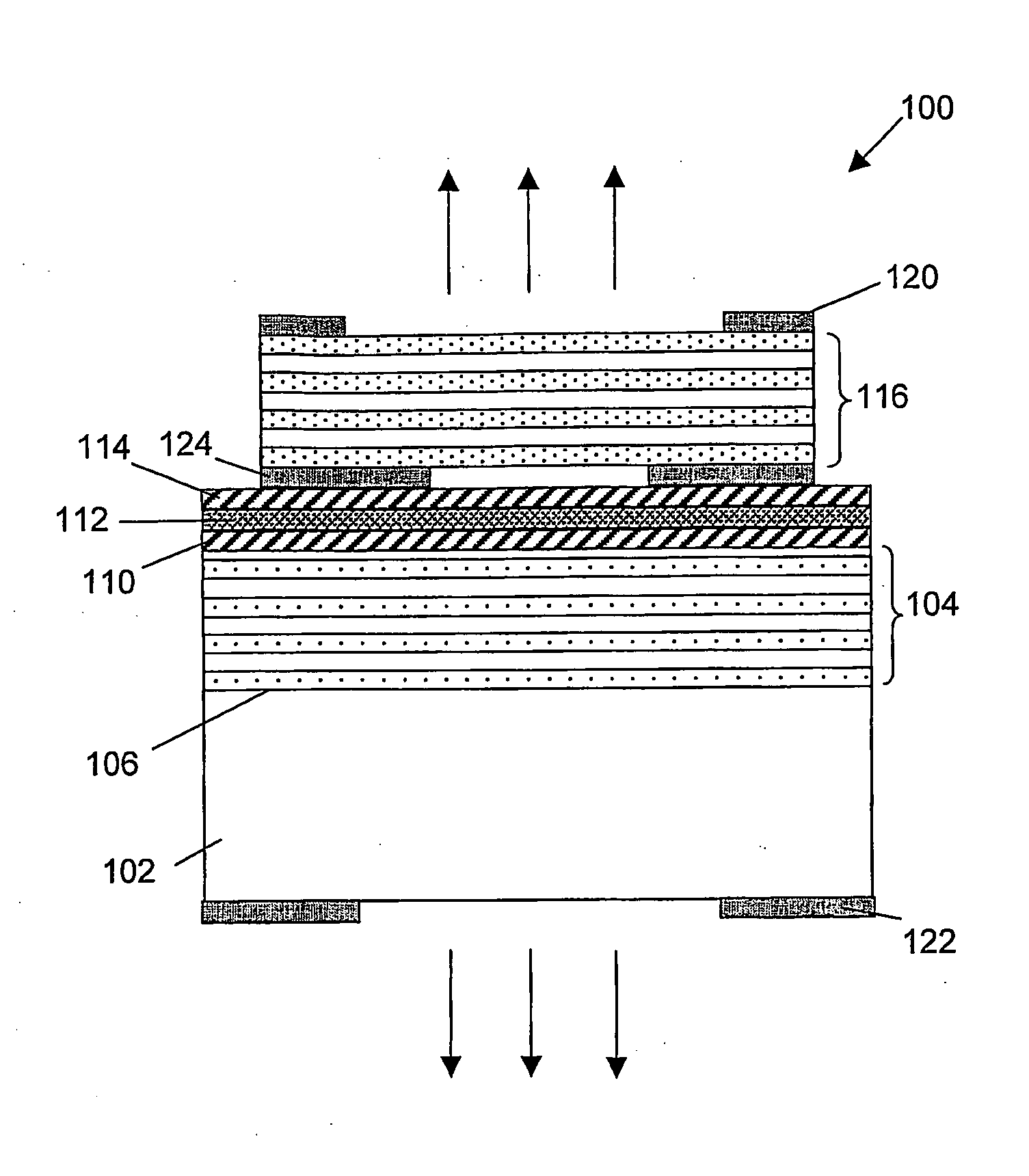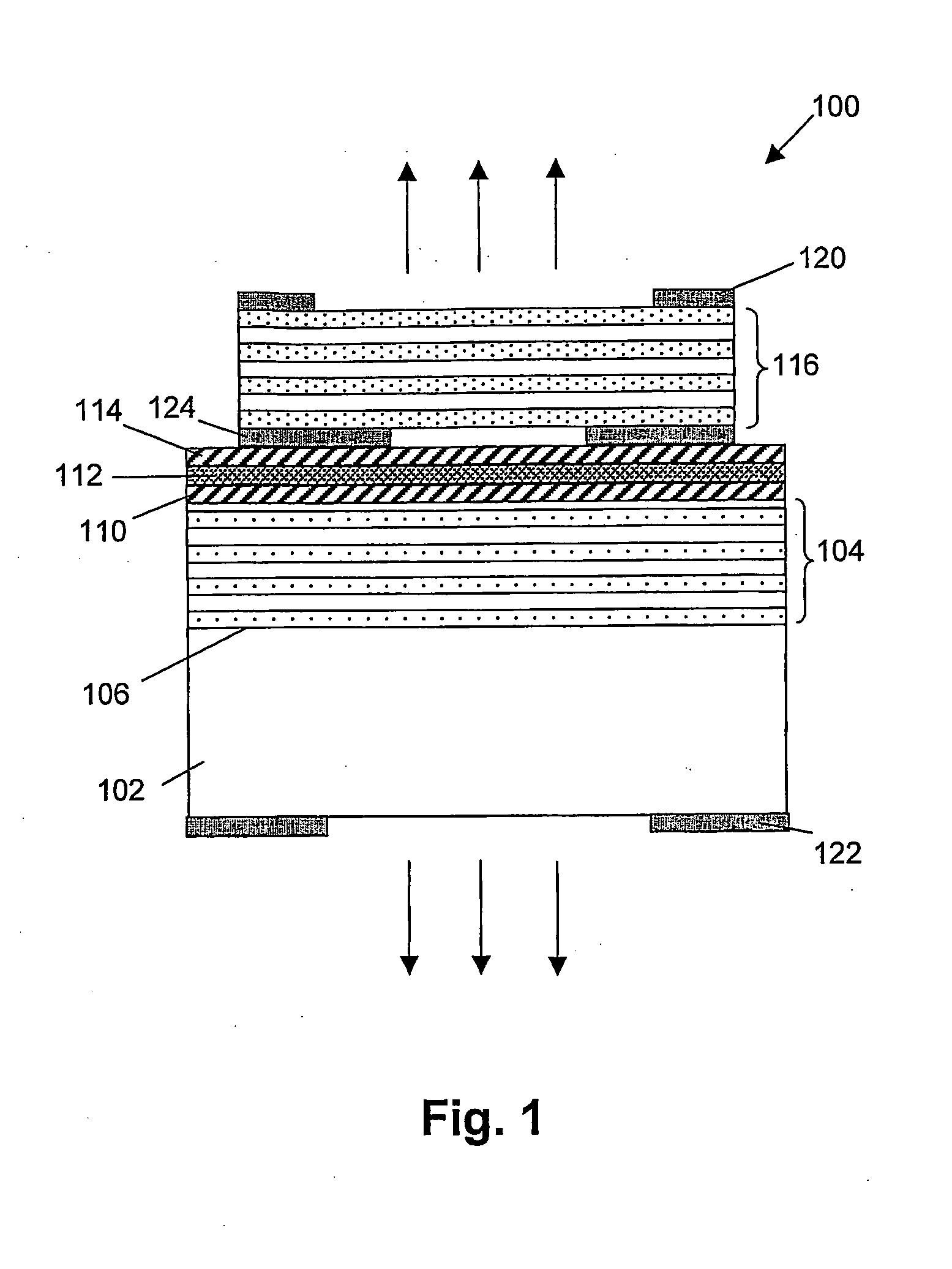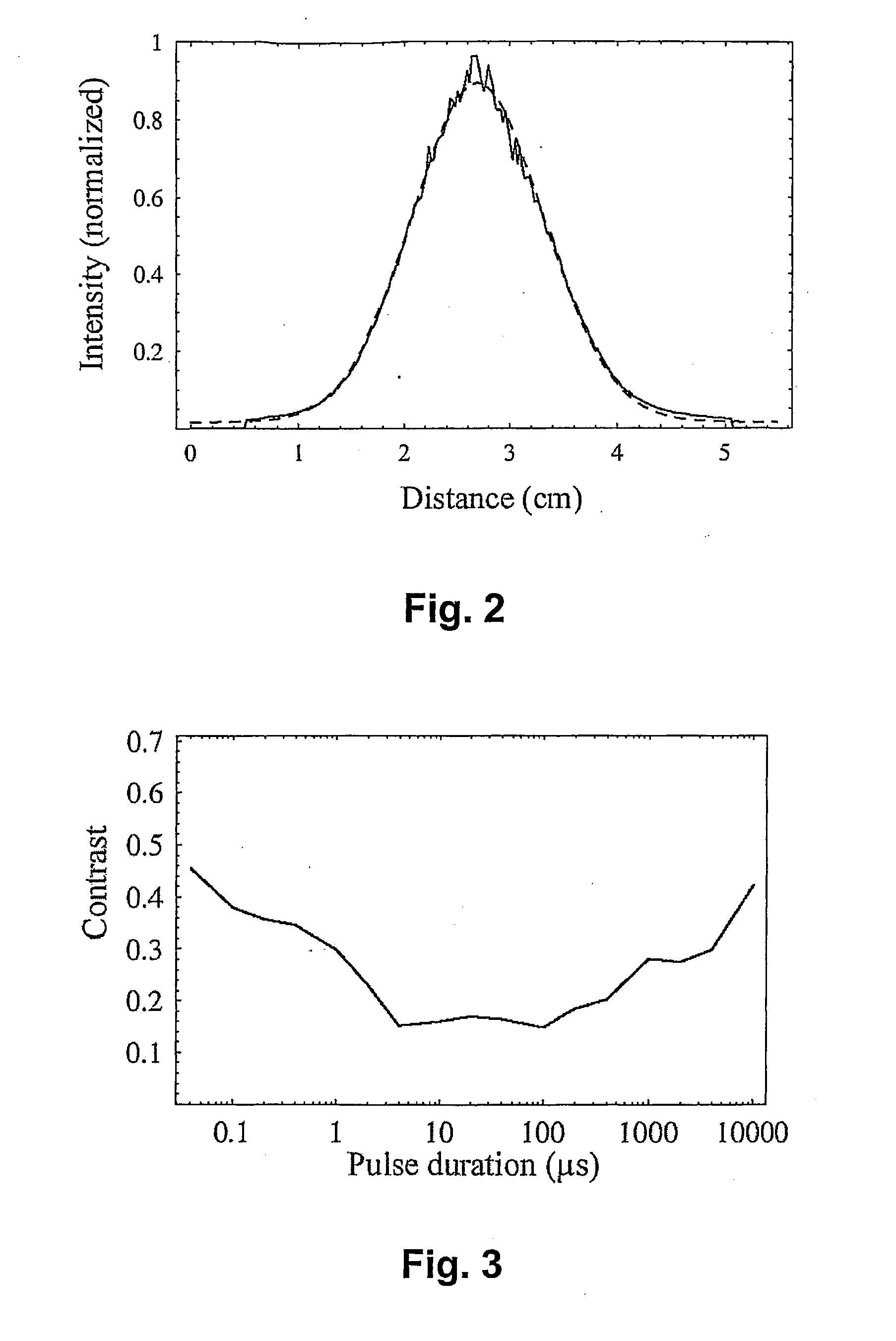[0007]It is an object of the present invention to provide improved microlasers and a method to drive microlasers. An
advantage of the present invention is that it can provide a method for optimising the far-field output of broad-area microlasers as well as microlasers used accordingly. For example the present invention can provide broad-area microlasers and a method for driving broad-area microlasers which allows a more desirable beam profile in the far field, such as e.g. a Gaussian
light beam profile.
[0008]The above objective is accomplished by a method according to the present invention. The invention relates to a method for driving a multi-mode broad area micro-
laser, the method comprising, driving said micro-
laser with an electric
driving current, said
driving current selected so as to obtain a reduced degree of spatial coherence transverse to said far field of said
light beam from said multi-mode broad area micro-
laser. Said light beam may be a laser beam. With a reduced degree of spatial coherence it is meant that the light beam is not completely coherent over its transverse profile. Light at two points within the transverse profile is considered to be coherent when the
degree of coherence exceeds 0.88. Light at two points within the transverse profile is considered to be partially coherent if the
degree of coherence is less than 0.88 but more than nearly zero. Light at two points within the transverse profile is considered to be incoherent if its
degree of coherence is nearly zero or zero. The degree of coherence thereby is determined as the
visibility V of the fringes of a two light beam interference test. This
visibility is defined as (Imax−Imin) / (Imax+Imin), with Imax being the
maximum intensity in the interference pattern and Imin being a minimum intensity in the interference pattern. A reduced degree of spatial coherence may mean that the coherence area of the beam, which is the area of the beam cross-section wherein the light is coherent, well defined e.g. by Mandel and Wolf in “Optical Coherence and
Quantum Optics” Wolf (Cambridge University Press 1995 ), is less than its aperture area. A reduced degree of spatial coherence of an illumination beam thus may be defined as an illumination beam having a coherence area smaller than the aperture area, more preferably smaller than one quarter the aperture area, even more preferably smaller than one tenth of the aperture area, still more preferably smaller than one hundredth of the aperture area, having as
lower limit, where the microlaser becomes indistinguishable from an incoherent
light source.
[0009]The method may comprise, for the micro-laser emitting at a resonant
wavelength λ, a driving current I(t) being selected such that the change of resonant
wavelength as a function of time t fulfilstλ(I(t))>110pmµsand the driving time t fulfils t>20 ns. Driving time t herein represents the time of actual driving, such as e.g. a
pulse duration for a pulsed driving current. The driving current may be a rectangular
current pulse having a
pulse height ph and apulse duration pd such thattλ(I(ph,pd))>110pmµsand pd>20 ns. The
pulse duration pd and said
pulse height ph may be selected such that 0.1 μs<pd<5000 μs and 30 mA<ph<500 mA. The selection of the driving current may be further restricted due to thermal conditions. The pulse duration may be in a range having a
lower limit of 0.1 μs, preferably 0.5 μs, more preferably 1 μs still more preferably 2 μs and an upper limit of 5000 μs, preferably 1000 μs, more preferably 500 μs, still more preferably 100 μs and the pulse height ph being selected larger than 30 mA, preferably larger than 75 mA, more preferably larger than 100 mA. It is to be noted that the pulse height of the current needed for performing driving according to the
present method will significantly depend on the design and growth conditions of the device driven. The driving current may be selected such that a contrast Co between interference fringes in a Young's experiment for at least part of the light in a far field of said light beam is smaller than a predetermined value A, i.e. Co<A. The contrast thereby may be defined as Co=|(Imax−Imin) / (Imax+Imin)|. It is to be noted that the contrast equals the
visibility of the interference fringes, which equals the degree of coherence. Young's experiment may be performed using an interference
mask comprising two apertures, being slits or pinholes. The apertures may be spaced apart by a distance of the
order of magnitude of the
diameter of the micro-laser. The distance may be between 1 and 10 times the
diameter of the micro-laser. The apertures may have a size between 0.1 and 10 times the
diameter of the micro-laser. The predetermined value A may be 0.88, preferably 0.5, more preferably 0.3, still more preferably 0.2. The multi-mode broad area micro-laser may be a multi-mode vertical cavity surface-emitting laser. The multi-mode broad area micro-laser may have an aperture with a characteristic diameter of more than 10 μm. The light output of said light beam having a reduced degree of spatial coherence may be used for any of microdensitometry,
line width experiments, laser range finders or
lithography applications.
[0010]The invention also relates to a method for tuning a light beam of a multi-mode broad area micro-laser, the method comprising driving during at least one first time period t1 the multi-mode broad area microlaser with an electric driving current selected so as to obtain a reduced degree of spatial coherence in the far field plane transverse to said light beam from said multi-mode broad area micro-laser, in order to adjust a light output of said spatial only partial coherent light beam. With a reduced degree of spatial coherence it is meant that the light beam is not completely coherent over its transverse profile. Coherency or the degree of coherence thereby is determined as the visibility V of the fringes of a two light beam interference test. A reduced degree of spatial coherence may mean that the coherence area of the beam is less than its aperture area. A reduced degree of spatial coherence of an illumination beam thus may be defined as an illumination beam having a coherence area smaller than the aperture area, more preferably smaller than one quarter the aperture area, even more preferably smaller than one tenth of the aperture area, still more preferably smaller than one hundredth of the aperture area, having as
lower limit, where the microlaser becomes indistinguishable from an incoherent
light source. Said driving current I(t) may be such that the change of resonant
wavelength as a function of time t fulfilstλ(I(t))>110pmµsand the driving time t fulfils t>20 ns. Said driving current I(t) may be a rectangular
current pulse and may have a pulse height ph and a pulse duration pd such that 0.1 μs<pd<5000 μs and 30 mA<ph<500 mA. The selection of the driving current may be further restricted due to thermal conditions. The pulse duration may be in a range having a lower limit of 0.1 μs, preferably 0.5 μs, more preferably 1 μs still more preferably 2 μs and an upper limit of 5000 μs, preferably 1000 μs, more preferably 500 μs, still more preferably 100 μs and the pulse height ph being selected larger than 30 mA, preferably larger than 75 mA, more preferably larger than 100 mA. Said tuning may furthermore comprise driving during at least one second time period t2 the multi-mode broad area microlaser with an electric driving current selected as to obtain a spatial substantially more coherent light beam from said multi-mode broad area micro-laser. With substantially more coherent light it is meant that the coherence area may be 10% larger, preferably 20% larger, more preferably 50% larger, even more preferably 75% larger, still more preferably 100% larger than the coherence area of the illumination beam obtained for driving during the at least one first time period t1. Said driving during said at least one first time period t1 and driving during said at least one second time period t2 may be used for transmitting signals. Said light output of the beam may be used for varying a resolution of a measurement.
[0011]The invention furthermore relates to a multi-mode broad area micro-laser, comprising a driver for driving said micro-laser with an electric driving current selected so as to obtain a reduced degree of spatial coherence in the far field plane transverse to said light beam from said multi-mode broad area micro-laser. With a reduced degree of spatial coherence it is meant that the light beam is not completely coherent over its transverse profile. The degree of coherence thereby is determined as the visibility V of the fringes of a two light beam interference test. A reduced degree of spatial coherence may mean that the coherence area of the beam is less than its aperture area. A reduced degree of spatial coherence of an illumination beam thus may be defined as an illumination beam having a coherence area smaller than the aperture area, more preferably smaller than one quarter the aperture area, even more preferably smaller than one tenth of the aperture area, still more preferably smaller than one hundredth of the aperture area, having as lower limit, where the microlaser becomes indistinguishable from an incoherent
light source. Said driving current I(t) may be such that the change of resonant wavelength as a function of time t fulfilstλ(I(t))>110pmµsand the driving time t fulfils t>20 ns. Driving time t herein represents the time of actual driving, such as e.g. a pulse duration for a pulsed driving current. Said driving current I(t) may be a rectangular
current pulse and may have a pulse height ph and a pulse duration pd such that 0.1 μs<pd<5000 μs and 30 mA<ph<500 mA. The selection of the driving current may be further restricted due to thermal conditions. The pulse duration may be in a range having a lower limit of 0.1 μs, preferably 0.5 μs, more preferably 1 μps still more preferably 2 μs and an upper limit of 5000 μs, preferably 1000 μs, more preferably 500 μs, still more preferably 100 μs and the pulse height ph being selected larger than 30 mA, preferably larger than 75 mA, more preferably larger than 100 mA.
[0012]The invention also relates to a driver for a multi-mode broad area micro-laser, comprising means for driving said micro-laser with an electric driving current selected as to obtain a reduced degree of spatial coherence in the far field plane transverse to said light beam from said multi-mode broad area micro-laser. With a reduced degree of spatial coherence it is meant that the light beam is not completely coherent over its transverse profile.
 Login to View More
Login to View More  Login to View More
Login to View More 


